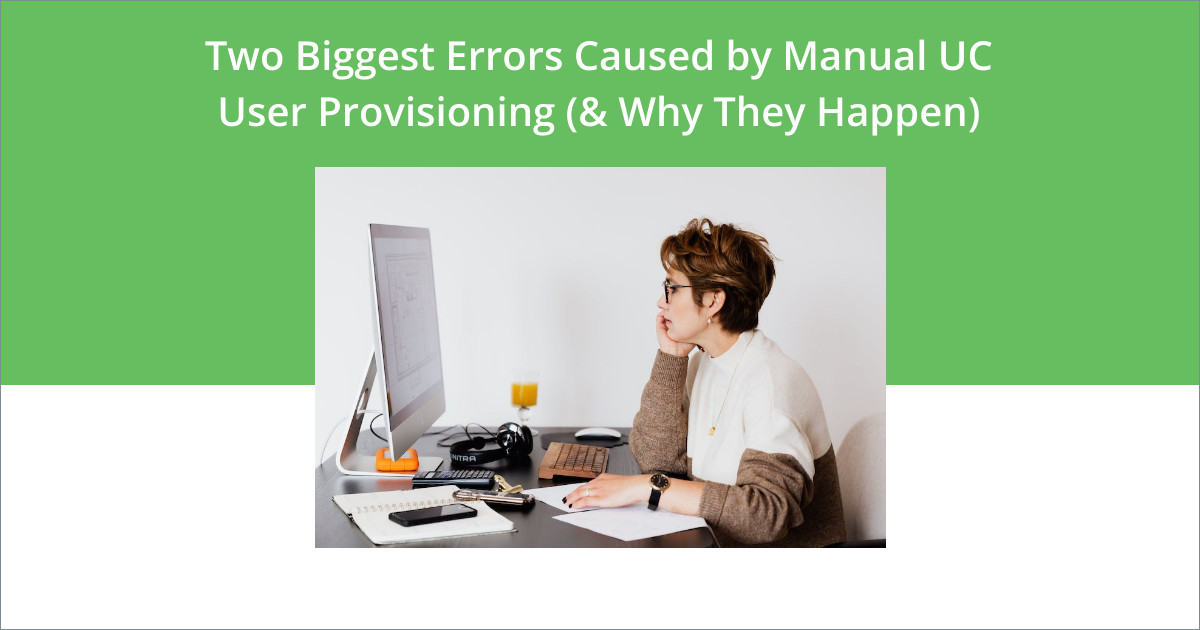Manual UC user provisioning leaves a lot of room for human error. In this blog, we cover the two most common errors, what causes them to keep happening, and what it means for your company.
Human error is an unavoidable reality when it comes to manual work. Any time a human interacts with data – even the most diligent UC engineer – there is always potential for mistakes to occur.
Manual UC user provisioning work is no exception. In many cases, it’s one of the most common places where errors occur, frustrating engineering teams and wasting valuable engineering time.
So, why does it happen so much?
Why Manual UC User Provisioning Causes Errors
Repetitiveness
Provisioning a user with the applications and devices they need means repetitively entering the same user data. Over time, it’s natural for people to try to get the task done quicker by taking shortcuts or not checking over their work to ensure that it’s accurate. This leads to easy mistakes.
Time
Provisioning one user across multiple applications and devices can take as long as 30 minutes. If you multiply that by the number of new hires a big, growing company onboards each month, it quickly adds up.
Long hours spent provisioning new users can drive workers to boredom, fatigue, or sloppiness. Consider a UC administrator with a handful of manual UC user provisioning tasks on their plate. The desire to rush through everything is completely understandable. After all, there is more strategic and impactful work they could be doing.
So, those are the causes. Now, let’s look at the effects.
The Two Most Prevalent Errors in Manual UC User Provisioning
Error #1 – Typos
When we talk about errors in UC provisioning, we’re mostly talking about typos. These happen every day, most commonly with peoples’ names.
Names vary widely, and one misread or fat-fingered letter can mean a name spelled wrong across every application. While this type of error is mostly harmless to your UC system, nothing makes a new hire feel less welcome.
Error #2 – Adding Wrong Extensions
Another more serious error in provisioning is adding the wrong extension. There has never been a great way to keep track of available extensions. Telephony managers doing it manually keep large spreadsheets that quickly become unwieldy.
As a result, a user may provision an extension that is already in use, either by another employee or, in the case of enterprise call center solutions like UCCX or UCCE, the IVR itself. This can lead to major problems such as dropped customer calls and outages.
Why Are UC User Provisioning Errors Such a Big Deal?
The above slip-ups may seem harmless compared to errors that could happen in other critical systems. And if your organization hasn’t yet run into major issues with UC user provisioning, it might be tempting to just keep doing what you’re doing.
But the truth is that as organizations grow, manual user provisioning time and errors only increase.
Left unchecked, these manual provisioning errors often result in service disruptions, and in extreme cases can cause costly outages, taking down communications for large swaths of your company all at once. This could mean interoffice communications going offline or worse – customer-facing call centers going offline.
There are also security risks associated with manual provisioning. Having employees make user changes directly in the UC applications themselves can lead to security breaches and opens the door to malicious activity.
For these reasons alone, it’s imperative companies find a solution to replace manual UC provisioning and management work.
Adding Automation to the UC User Provisioning Workflow
It’s no secret that the more you can automate, the more human errors you’ll prevent. The same goes for provisioning users and devices in your unified communications solution.
Automated UC provisioning software allows UC engineer and IT professionals to automate the manual move, add, change, and delete (MACD) tasks that take up so much of their time and resources.
Today’s automated solutions have sophisticated templating and easy interfaces that make quick work of UC provisioning tasks, dramatically reducing or eliminating errors in provisioning.
Good solutions can also integrate natively with Active Directory and ServiceNow, enabling zero-touch UC provisioning. Without any human intervention a robust UC provisioning automation solution can take that data and provision a user across an entire Cisco Collaboration, Webex or Microsoft Teams environment.
Conclusion
Manual UC user provisioning is tedious work that takes time away from more engaging and strategic initiatives. Giving your IT or UC teams a solution that removes the burden doesn’t just save money – it improves job satisfaction and aids retention.
Now that you know how to streamline UC for your users, your next step is to find a partner that can help you implement a solution that makes sense for your organization and existing technology.
Want to eliminate provisioning errors? Talk to us today about your specific UC environment and technology needs.



